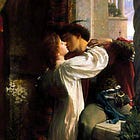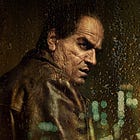If you’re new here, read this quick primer on the Story Energies, a new way to talk about storytelling.
A romance is a story. Potentially, like a career, or a faith, or the birthing and shepherding of a new person into the world, one of the big ones. Part of the excitement that comes with falling in love is the feeling that this might end up as one of the major plot lines in what you will one day look back upon as the story of your life.
According to standard storytelling advice, a romance should be fuelled by an irrepressible desire for that other person. There should be obstacles, of course, but those should be overcome because you are meant to be together. And once the barriers have been hurdled, you can live happily ever after1.
Alas, of course, it doesn’t always work out that way. Desire can fizzle. Obstacles can prove insurmountable. We can get distracted by other stories—our jobs, our sports teams, our co-worker’s perfect hair.
And, of course, the same can happen with any story we involve ourselves in. We get burnt out at work, our prayers go unanswered, our kids go to college and stop returning calls. Story gets complicated, confusing, confounding. We do not, we learn, if we pay attention, have any real control over anything at all. And maybe these stories we were telling ourselves were really just fantasies, fictions contrived by our grasping imaginations?
This week here on Substack, Rayne Fisher-Quann told the story of her three-year relationship. This was one of those “cataclysmic, world-shifting” romances, and it also became one of those that didn’t work out. And one of the things that her essay captures is how, when a romance stops working the way it’s supposed to, that doesn’t mean we stop trying to make sense of it. To shape it into a coherent narrative. Instead, we often find the story of the romance more compelling than ever…
I spent hours every day walking aimlessly around the city, watching the leaves curdle on the trees and trying to weave the loose threads of our relationship into a story that made sense […] Was I a good partner, or was I a bad partner? Did I hurt him, or did he hurt me? Was the great tragedy of our relationship that we’d been doomed from the start, or that we veered off track somewhere, quietly, imperceptibly, and were too far gone by the time we’d realized it?
She knows that this obsessing over her dead or dying dream is neither a useful nor a pleasant way to spend her time and energy, but she can’t help it. She tells us that she never had so much trouble writing an essay as this one, and that she has written and deleted thousands of words. And even this draft she’s arrived at over a year after starting still feels, in some ways, stuck in the moment, with its entrancing evocations of the relationship, good times and bad.
She turns to other writers for help. Mary Gaitskill’s take is that narrative is our (deluded) attempt to triumph over suffering, rather than to tolerate it. And Susan Sontag mourns our compulsion to reduce an artwork to its content and impose our interpretation, rather than to commit to experiencing the complex feelings it provokes in us. To caption it, with thoughts, and weave that meaning into Story we can understand.
Interpretation, Fisher-Quann acknowledges, is what she is imposing on her relationship in her essay, even as the whole point she’s trying to make is that any attempts to understand love will ultimately prove futile…
The cruelty of this project, of course, is that I’m setting out to do exactly what I aim to condemn: I am trying to describe the indescribable, to turn something sacred into something consumable and finite. So I will try to stop telling the story, for that reason and also because I find it hard to convince myself that any of it would matter — if it would really mean anything to you to hear about the morning sun in his irises, the cold showers in the heatwave, the mud, the vomit, the sex, the dinners, the dirty dishes made clean and then dirty again.
Above the essay, you’ll find the caption she put on it: against narrative.
Since launching this Substack two weeks ago, I have written about the advantages of making characters very different from one another2. I’ve described how equipping a character with a physical or emotional lack or longing3 can help charge their lives, and your story, with meaning. I’ve noted some lessons we can learn from Romeo & Juliet. None of this is inconsistent with standard storytelling advice, in service of escalating conflict towards a resonating climax.
But the reason I developed the Story Energies in the first place was because this standard storytelling advice doesn’t work for all stories. Not all stories want to assume that ‘traditional’, ‘classical’ form. If our lives are filled with narratives that don’t always arrive at clean, neat resolutions, where everything in the end makes a kind of sense, then some of us will want to reflect that in our stories—our fiction, our movies, our TV shows, our podcasts, our essays.
Climaxes are not for everyone. But even if we want our stories to mirror, in some way, the messiness of life, we still, as storytellers, want to captivate our readers and audiences, and to keep them captivated until we’re done. And to leave them, in the end, moved by some kind of feeling.
I was captivated by against narrative. And if I want to understand why, and to learn from it, I could look at all the Story Energies at play. The Potential Energy of a young couple uplifted by desire and hope. The Gravitational Energy of our world where things sometimes don’t work out, that brings them crashing down to earth. The powerful Magnetic Energy, the attraction and repulsion, of their bond. The Electrical Energy, the emotion and the atmosphere, that pervades the telling. The Nuclear Energy in all those specific, compelling details, that iris-trapped morning sunlight, those dirty dishes. The Elastic Energy in that tension between the author’s need to explain how much her relationship means to her, and her understanding that she will never be able to contain that meaning in words and sentences, in an argument.
We can turn our back on Story. We can read the postmodernists, see through the mythologies, acknowledge the meaningless suffering that’s going to come to everyone some day. We can declare ourselves against narrative, for cause. But it follows. All of us, I think, just can’t help trying to scramble for meaning, so that we can feel, as I’ve said here already, as if we’re in control of our lives, and as if those lives are important in a way we can understand and feel good about. This is just part of the experience of being a person.
This is why, I think, despite everything we have learned, that classical mode of storytelling, and all the standard storytelling advice that comes with it, is so enduring. Even if the real-life stories we involve ourselves in don’t always add up to some sort of coherent meaning, part of us wants them to.
And if life is suffering, it is also joy. It’s the excitement and elation and pleasure of love, the comfort of companionship and trust. It’s the satisfaction of a job well done, the pride in a kid’s graduation, the wonder of a spiritual awakening, or the view from the top of a mountain you’ve just climbed.
Story is never really about the answers arrived at, but the journey, the quest, the struggle itself. And whether you want to portray the inability of narrative to capture the true essence of lived experience, or just to tell a ripping yarn, the Story Energies can help you. By asking yourself how you can charge a story with more of each form of Energy, you can come up with new ways to make it more compelling. Give it a try next time you’re telling a story. And come back and let me know how it went.
You can go see Mark Rothko’s Orange and Yellow at the Albright-Knox Art Gallery in Buffalo, New York.
You can read Rayne Fisher-Quann’s essay here:
Unless we accidentally get trapped in one of those heartbreaking tragedies.
Like the sisters in His Three Daughters
Like Oz Cobb’s foot in The Penguin













